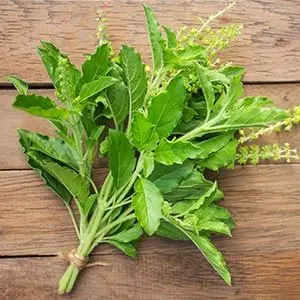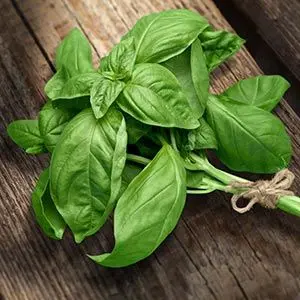Basil: Elevate Your Pet's Meals with This Nutrient-Rich Herb
A staple in many cuisines worldwide, this well-loved culinary herb offers not only flavor but also beneficial phytonutrients that may help protect against oxidation, inflammation and more. Find out how you can add it to your pet’s meal.

STORY AT-A-GLANCE
- Common basil is a popular culinary herb with fragrant, delicate leaves that are glossy, smooth and vibrant green; its flavor is described to be a mix between anise, mint and pepper
- This well-loved herb offers an array of health-boosting nutrients and phytochemicals that can benefit you and your pet
- Among the polyphenols found in basil, rosmarinic and chicoric acids are the most abundant, both of which have potent antioxidant effects and other pharmacological properties
- Whether fresh or dried, you can sprinkle basil on your pet’s meal as a food topper or use it as an ingredient in their homemade treats
Editor's Note: This article was originally published August 3, 2023.
Throughout history, basil has been celebrated not only for its culinary use but also for its symbolic and religious meanings in different cultures. But did you know that this well-loved herb also offers an array of health-boosting nutrients and phytochemicals that can benefit you and your pet? Continue reading to learn how you can offer this herb to your furry best friend.
What Is Basil and Is It Good for Pets?
The basil plant genus (Ocimum) belongs to the mint family (Lamiaceae) and has more than 160 different species. However, when people talk about basil, the species they’re most likely referring to is common basil (Ocimum basilicum) and its different variants, such as Thai basil (Ocimum basilicum var. thyrsiflora).1 For this reason, we will focus on the uses and health benefits of this particular species in this article.
Also known as sweet basil, common basil is a popular culinary herb with fragrant, delicate leaves that are glossy, smooth and vibrant green. The flavor is described to be a mix between anise, mint and pepper, although some varieties are named after their distinct taste, like lemon basil, cinnamon basil and spicy bush basil.2,3
Used fresh or dried, and best added at the end of the cooking process to preserve its intense flavor, basil is known as the key ingredient in pesto sauce and lends a distinctive flavor to pasta, pizza, salad and many other dishes.4 Another thing basil is known for is its wide array of therapeutic properties, thanks to its high concentrations of bioactive compounds.5 According to a study published in the International Journal of Food Properties:6
“The most important pharmacological uses of basil are anti-cancer activity, radioprotective activity, anti-microbial activity, anti-inflammatory effects, immunomodulatory activity, anti-stress activity, anti-diabetic activity, anti-pyretic activity, anti-arthritic activity, anti-oxidant activity, as a prophylactic agent and in cardiovascular disease.”
Moreover, it contains a variety of vitamins and minerals, including vitamin K, magnesium and pro-vitamin A (beta-carotene).7 The good news is, just like you, your furry best friend can enjoy the health benefits of basil, as it can be incorporated as a healthy ingredient into their homemade treats or nutritionally balanced, species-appropriate meals.
Common Basil vs. Holy Basil: What’s the Difference?

Despite having similar names and belonging to the same plant genus Ocimum, basil and holy basil are two different species that are not interchangeable in recipes. They differ not just in taste and appearance but also in pharmacological properties.
Holy basil, also called tulsi, has a hairy stem as well as jagged leaves that taste peppery and spicy, similar to cloves. One of its most notable benefits is the ability to help lower stress load by reducing cortisol levels.8
Basil Is Loaded with Powerful Antioxidants
“The most important antioxidant compounds found in basil are caffeic acid, vanillic acid, rosmarinic acid, quercetin, rutin, apigenin, and chlorogenic and p-hydroxybenzoic acid.”9
If you have purple basil at home, then you’ll be pleased to know that it’s also a very rich natural source of anthocyanin,10 another potent antioxidant and anti-inflammatory compound.11 Studies have shown that increased intake of herbs containing these bioactive compounds resulted in improved immune response and lower morbidity and mortality rates in animals.12
Moreover, an article published in the journal Plants (Basel) noted that extracts from the aerial parts of basil, such as the leaves and stems, have hypoglycemic, hepatoprotective, cardioprotective and antimycobacterial activities, due in part to its antioxidant properties.13
Chicoric and Rosmarinic Acids: The Major Compounds in Basil
Among the polyphenols found in basil, rosmarinic and chicoric acids are the most abundant.14 Rosmarinic acid is a powerful free radical scavenger that also exerts other pharmacological effects, including antimicrobial, anti-inflammatory, antimutagenic, antiviral and anticancer, which is why it’s considered a potential treatment for ulcers, cataracts, arthritis, neurodegenerative disorders, cardiovascular disease and other illnesses.15
Rosmarinic acid also exerts hypoglycemic action, which research shows may benefit diabetic dogs as well. In a study published in the journal Veterinary World, rottweilers given basil leaf powder experienced blood glucose reduction of up to 31%. The researchers concluded that basil is a promising blood glucose level modulator, as well as a “clinico-nutritional management tool for the prevention and control of diabetes mellitus in dogs.”16
As for chicoric acid, it has antiviral, antioxidant, anti-inflammatory, antiobesity and neuroprotective effects.17 Moreover, an animal study published in the journal Pharmacology, Biochemistry, and Behavior found that it may help regulate behavioral and biochemical alterations caused by chronic stress.18
Did You Know?

Basil is believed to have been cultivated for more than 5,000 years, with its origin tracing back to India. It got its name from the Greek phrase “basilikon phuton,” which means “royal or kingly herb,” hence why it’s also sometimes called “king of herbs.”19
Basil Compounds May Also Help Fight Anxiety and Bacteria
According to an animal study published in the journal Research in Pharmaceutical Sciences, the phenols and terpenoid components in basil exert anxiolytic and sedative effects, making it potentially useful for reducing anxiety.20 It’s also helpful in fighting a wide range of Gram-negative and Gram-positive microorganisms.21
A study published in the African Journal of Traditional, Complementary and Alternative Medicines further demonstrated the antimicrobial activity of basil. According to the researchers, its methanol extracts “showed inhibition zones against strains of Pseudomonas aeruginosa, Shigella sp., Listeria monocytogenes, Staphylococcus aureus and two different strains of Escherichia coli.”22
How to Choose Basil and Offer It to Your Pet
Basil can be shared with pets either in dry form from your spice cabinet or fresh from the garden, if you’re lucky to have verdant clumps of basil growing at home. For fresh basil, pinch off several leaves from the top of the plant, rinse them under running water and chop them into smaller pieces before offering them to your pet. Most dogs readily accept 1/2 to 1 teaspoon of minced basil for every 10 pounds of body weight (half that amount for cats) mixed in with their food.
Dried herbs are more potent, so about 1/4 to 1/2 teaspoon of dried basil (half that amount for cats) can be sprinkled on your pet’s meal, mixed in as a food topper, or used as an ingredient in their homemade treats. You can also use it to season an onion-free bone broth for your pet, or combine it with other fresh herbs like cilantro, thyme, rosemary and lemon verbena to make a detox tea for your dog. When offering healthy treats to your pet, including snacks containing basil, remember to limit them to less than 10% of your pet’s daily caloric intake.
Try Making These Basil Treats for Your Pet
If you’re looking for different ways to serve basil to your pet, try this recipe, which supercharges basil’s free radical scavenging capacity by combining it with other antioxidant-rich ingredients:
Antioxidant Cookies
Ingredients:
- ½ cup organic blueberries, chopped
- 1 cup ground bison or turkey
- 1 teaspoon turmeric
- 1 tablespoon dried basil
- 1 tablespoon coconut flour
Procedure:
- Mix all ingredients together, then roll into 1-inch balls. Press flat with a fork.
- Bake on a greased cookie sheet at 400°F (204°C) for 20 minutes. Let cool before giving to your pets.
Which States Produce the Most Basil?

Basil is grown commercially in the western and southern states, where the climate is favorable for the plant’s cultivation. The top basil-producing states are Arizona, California, Florida, New Mexico and North Carolina.23

Sustainability of Basil
Commercial basil production is considered sustainable, as it does not have a significant impact on air, water, land and soil. The use of pesticides is also uncommon because the plant is fairly unaffected by insects. However, some growers may use herbicides like glyphosate on their crops to prevent weeds, which could be damaging to your and your pet’s health.24,25
So, when buying basil, make sure to choose spray-free, organic varieties, preferably from a local farmers market. Basil is also easy to grow, so consider planting one in a pot at home. Not only will this provide you with your own supply of fresh basil whenever you need it, but it also helps you guarantee that the basil you’re feeding your family is safe and sustainable.
Sources and References
- 1 NFS Journal. Volume 26, March 2022, Pages 1-9
- 2 The Spruce Eats, September 19, 2022
- 3 Masterclass, August 6, 2021
- 4 The Spruce Eats, September 19, 2022
- 5 Foods. 2022 May; 11(9): 1239
- 6,9 International Journal of Food Properties Volume 23, 2020 - Issue 1 Pages 1961-1970
- 7 Medical News Today, Health Benefits of Basil
- 8 Front Nutr. 2022; 9: 965130
- 10,13,14 Plants (Basel). 2020 Jan; 9(1): 22
- 11 Front. Pharmacol., 26 August 2020 Volume 11
- 12 Arch Pharm Res. 2022; 45(4): 205–228
- 15 Foods 2022, 11(20), 3212
- 16 Vet World. 2020 Jan;13(1):73-79
- 17 J Med Food. 2019 Jul;22(7):645-652
- 18 Pharmacol Biochem Behav. 2011 Sep;99(3):342-8
- 19 The Spruce Eats, August 13, 2019
- 20 Res Pharm Sci. 2015 Nov-Dec; 10(6): 535–543
- 21 J Agric Food Chem. 2003 May 21;51(11):3197-207
- 22 Afr J Tradit Complement Altern Med. 2008; 5(4): 363–369
- 23 Western Institute for Food Safety and Security, Basil
- 24 FoodPrint, Basil
- 25 Healabel, January 3, 2023











